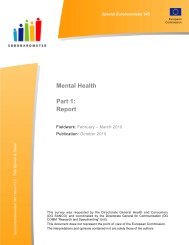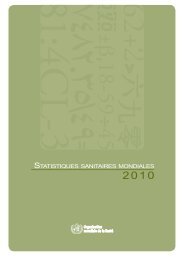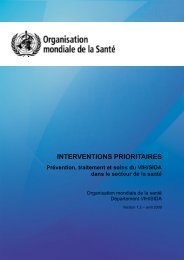Global Tuberculosis Control 2010 - Florida Department of Health
Global Tuberculosis Control 2010 - Florida Department of Health
Global Tuberculosis Control 2010 - Florida Department of Health
You also want an ePaper? Increase the reach of your titles
YUMPU automatically turns print PDFs into web optimized ePapers that Google loves.
ogress made towards achieving the impact targets<br />
set for 2015 – to halt and reverse the incidence <strong>of</strong> TB<br />
by 2015 (MDG Target 6.c), and to halve prevalence and<br />
mortality rates compared with a baseline <strong>of</strong> 1990 (the<br />
targets set by the Stop TB Partnership) – is illustrated<br />
at the global level in and at the regional level<br />
in , and . 1 Progress in<br />
achieving reductions in incidence and mortality is shown<br />
for each <strong>of</strong> the 22 HBCs in and .<br />
<strong>Global</strong>ly, rates <strong>of</strong> incidence, prevalence and mortality<br />
are all declining (). Incidence rates are falling<br />
slowly, at around 1% per year, following a peak at just<br />
over 140 cases per 100 000 population in 2004. If current<br />
trends are sustained, then MDG Target 6.c will be<br />
achieved. Mortality rates have fallen by one third since<br />
1990, and prevalence rates are also in decline. Projections<br />
suggest that the target <strong>of</strong> halving mortality by<br />
2015 compared with 1990 could be achieved at global<br />
level. The target <strong>of</strong> halving the prevalence rate appears<br />
out <strong>of</strong> reach. It should be noted, however, that there is<br />
more uncertainty about trends in prevalence, compared<br />
with trends in mortality (see also ).<br />
Regionally, incidence rates are declining in five <strong>of</strong><br />
WHO’s six regions (). The exception is the<br />
South-East Asia Region (where the incidence rate is stable),<br />
largely explained by apparent stability in the TB<br />
incidence rate in India. Further evaluation <strong>of</strong> trends<br />
in the disease burden in India is needed, and has been<br />
planned for early 2011. Among the five regions where<br />
incidence rates are falling, the rate <strong>of</strong> decline varies from<br />
less than 1% per year in the Eastern Mediterranean and<br />
European regions to around 2% per year in the African<br />
Region (since 2004) and 4% per year in the Region <strong>of</strong><br />
the Americas. As also illustrated in , notifications<br />
are closest to estimated incidence in the Region <strong>of</strong><br />
the Americas and the European Region, indicating that<br />
the highest rates <strong>of</strong> case detection are achieved in these<br />
regions (see also ). As incidence falls slowly,<br />
notifications are increasing in the African Region and<br />
(particularly since 2000) in the Eastern Mediterranean<br />
and South-East Asia regions, indicating improving rates<br />
<strong>of</strong> case detection. In the Western Pacific Region, notifications<br />
increased sharply between 2002 and 2006, but<br />
have since stabilized; here, patterns are strongly influenced<br />
by China, which accounts for almost 70% <strong>of</strong> incident<br />
cases in this region ().<br />
The latest assessment for the 22 HBCs suggests that<br />
incidence rates are falling or stable in all countries<br />
except South Africa (). Trends in incidence<br />
rates are assumed to be stable in Afghanistan, Bangladesh,<br />
India, Indonesia, Myanmar and Pakistan, in the<br />
absence <strong>of</strong> convincing evidence to the contrary (<br />
). The stability in TB incidence rates in India (which<br />
accounts for 61% <strong>of</strong> cases in this region) as well as Bangladesh,<br />
Indonesia and Myanmar explains the flat trend<br />
in estimated incidence in the South-East Asia Region.<br />
<br />
<br />
<br />
<br />
<br />
<br />
<br />
Incidence and notifications Mortality Prevalence<br />
140<br />
35<br />
300<br />
Rate per 100 000 population<br />
120<br />
100<br />
80<br />
60<br />
40<br />
20<br />
30<br />
25<br />
20<br />
15<br />
10<br />
5<br />
250<br />
200<br />
150<br />
100<br />
50<br />
0<br />
0<br />
0<br />
1990 1995 2000 2005<br />
1990 1995 2000 2005 <strong>2010</strong> 2015 1990 1995 2000 2005 <strong>2010</strong> 2015<br />
1<br />
See in <strong>of</strong> this report for definitions <strong>of</strong> the global<br />
targets for TB control.

















